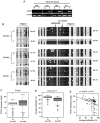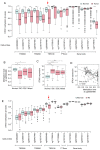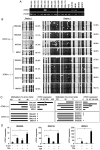STK31 upregulation is associated with chromatin remodeling in gastric cancer and induction of tumorigenicity in a xenograft mouse model
- PMID: 33649810
- PMCID: PMC7934220
- DOI: 10.3892/or.2021.7993
STK31 upregulation is associated with chromatin remodeling in gastric cancer and induction of tumorigenicity in a xenograft mouse model
Abstract
Pathological changes in the epigenetic landscape of chromatin are hallmarks of cancer. Our previous study showed that global methylation of promoters may increase or decrease during the transition from gastric mucosa to intestinal metaplasia (IM) to gastric cancer (GC). Here, CpG hypomethylation of the serine/threonine kinase STK31 promoter in IM and GC was detected in a reduced representation bisulfite sequencing database. STK31 hypomethylation, which resulted in its upregulation in 120 cases of primary GC, was confirmed. Using public genome‑wide histone modification data, upregulation of STK31 promoter activity was detected in primary GC but not in normal mucosae, suggesting that STK31 may be repressed in gastric mucosa but activated in GC as a consequence of hypomethylation‑associated chromatin remodeling. STK31 knockdown suppressed the proliferation, colony formation and migration activities of GC cells in vitro, whereas stable overexpression of STK31 promoted the proliferation, colony formation, and migration activities of GC cells in vitro and tumorigenesis in nude mice. Patients with GC in which STK31 was upregulated exhibited significantly shorter survival times in a combined cohort. Thus, activation of STK31 by chromatin remodeling may be associated with gastric carcinogenesis and also may help predict GC prognosis.
Keywords: serine/threonine kinase 31; gastric cancer; DNA hypomethylation; chromatin remodeling; prognosis.
Conflict of interest statement
The authors declare that they have no competing interests.
Figures








Similar articles
-
ONECUT2 upregulation is associated with CpG hypomethylation at promoter-proximal DNA in gastric cancer and triggers ACSL5.Int J Cancer. 2020 Jun 15;146(12):3354-3368. doi: 10.1002/ijc.32946. Epub 2020 Mar 20. Int J Cancer. 2020. PMID: 32129880 Free PMC article.
-
Connexin 32 and 43 promoter methylation in Helicobacter pylori-associated gastric tumorigenesis.World J Gastroenterol. 2014 Sep 7;20(33):11770-9. doi: 10.3748/wjg.v20.i33.11770. World J Gastroenterol. 2014. PMID: 25206281 Free PMC article.
-
DNA hypomethylation promotes invasion and metastasis of gastric cancer cells by regulating the binding of SP1 to the CDCA3 promoter.J Cell Biochem. 2020 Jan;121(1):142-151. doi: 10.1002/jcb.28993. Epub 2019 Jun 18. J Cell Biochem. 2020. PMID: 31211445
-
Chromatin and noncoding RNA-mediated mechanisms of gastric tumorigenesis.Exp Mol Med. 2023 Jan;55(1):22-31. doi: 10.1038/s12276-023-00926-0. Epub 2023 Jan 19. Exp Mol Med. 2023. PMID: 36653445 Free PMC article. Review.
-
Current and potential biomarkers in gastric cancer: a critical review of the literature.Future Oncol. 2021 Sep;17(25):3383-3396. doi: 10.2217/fon-2021-0084. Epub 2021 Jul 22. Future Oncol. 2021. PMID: 34291647 Review.
Cited by
-
Expression and prognostic potential of ribosome 18S RNA m6A methyltransferase METTL5 in gastric cancer.Cancer Cell Int. 2021 Oct 26;21(1):569. doi: 10.1186/s12935-021-02274-3. Cancer Cell Int. 2021. PMID: 34702266 Free PMC article.
-
Uncovering a multitude of stage-specific splice variants and putative protein isoforms generated along mouse spermatogenesis.BMC Genomics. 2024 Mar 20;25(1):295. doi: 10.1186/s12864-024-10170-z. BMC Genomics. 2024. PMID: 38509455 Free PMC article.
-
STK31 drives tumor immune evasion through STAT3-IL-6 mediated CD8+ T cell exhaustion.Oncogene. 2025 Jun;44(20):1452-1462. doi: 10.1038/s41388-024-03271-2. Epub 2025 Mar 1. Oncogene. 2025. PMID: 40025230
References
-
- Correa P. Human gastric carcinogenesis: A multistep and multifactorial process-First American Cancer Society Award Lecture on Cancer Epidemiology and Prevention. Cancer Res. 1992;52:6735–6740. - PubMed
MeSH terms
Substances
LinkOut - more resources
Full Text Sources
Other Literature Sources
Medical
Molecular Biology Databases
Miscellaneous

